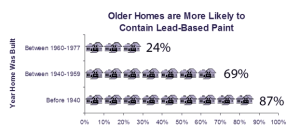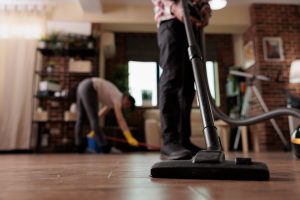Spring Cleaning and Lead in Your Environment
Spring cleaning is an excellent opportunity to reduce lead exposure in your environment. Lead can accumulate in dust and soil and cause harm to both your health and the environment.
Download and print our flyer with information about lead in the home in English and Spanish.
Tips for Cleaning Homes with Lead Paint
- Test for lead: Before starting any cleaning or renovation project, it is essential to know whether there is any lead present in your home. You can purchase a lead testing kit from your local hardware store or hire a professional lead inspector to test your home for lead, but we strongly recommend any remediation be done by a professional.
- Keep painted surfaces clean: Keep painted surfaces clean and free of dust. Clean floors, window frames, windowsills, and other surfaces weekly. Use a mop or sponge with warm water and a general all-purpose cleaner. (Remember: never mix ammonia and bleach products together because they can form a dangerous gas.)
- Clean regularly: Regular cleaning is essential for maintaining a healthy home environment. Clean with a damp cloth to avoid creating dust that may contain lead particles. Use a vacuum cleaner with a high-efficiency particulate air (HEPA) filter to clean floors and carpets, and wipe down surfaces with a damp cloth to remove dust and dirt.
- Use lead-safe cleaning products: Many common cleaning products contain harsh chemicals that can release lead into the environment. To reduce your exposure to lead, look for cleaning products that are labeled as “lead-safe” or “lead-free.”
- Dispose of lead properly: If you have any lead-based products or materials in your home, such as old paint, batteries, or electronics, it is important to dispose of them properly. Contact your local hazardous waste facility or recycling center to determine how to safely dispose of these materials.
 (2)
(2)
Cleaning Tasks:
- Dusting: Lead dust can accumulate on surfaces and objects, so it is essential to dust frequently with a damp cloth or mop to capture any lead particles.
- Vacuuming: Use a vacuum cleaner with a high-efficiency particulate air (HEPA) filter to trap lead dust, especially on floors and carpets. (Read more below).
- Mopping: Wet mopping can effectively remove lead dust from floors and surfaces. Use a cleaning solution without ammonia, as ammonia can react with lead and make it more harmful. When cleaning surfaces in your home, use wet cleaning methods such as damp mopping or wiping to prevent lead dust from becoming airborne. Thoroughly rinse sponges and mop heads after cleaning dirty or dusty areas. (1)
- Cleaning household items: Wipe down any household items that may have lead on them, such as toys, furniture, or window sills. Avoid abrasive cleaners that can create more dust. Keep play areas clean. Wash bottles, pacifiers, toys, and stuffed animals regularly. (1)
- Washing hands: Wash hands and any exposed skin regularly, especially before eating or drinking. Lead can accumulate on yours and your children’s hands, so wash your hands and your children’s hands frequently, especially before eating.
Vacuuming to Avoid Spreading Lead
Vacuuming can stir up lead dust, so taking precautions to avoid spreading it in your environment is necessary. Inhaling or ingesting lead dust can lead to lead poisoning, so if you have lead paint in your home or workspace, it is important to take precautions while vacuuming to avoid spreading lead in your environment. Here are some tips to vacuum safely:
- Avoid using a broom: Using a broom can stir up dust and make it more difficult to clean up. Instead, use a vacuum or wet mop to clean floors.
- Use a high-efficiency particulate air (HEPA)-filtered vacuum: A HEPA filter can trap lead dust and prevent it from being released back into the air. Make sure your vacuum cleaner has a HEPA filter installed and change the filter regularly according to the manufacturer’s instructions. Use a HEPA filter vacuum cleaner: A vacuum cleaner with a HEPA filter can trap fine particles, including lead dust, and prevent them from being released back into the air.
- Wet clean surfaces before vacuuming: Use a damp cloth or mop to clean surfaces before you vacuum. This can prevent the dust from becoming airborne when you vacuum.
- Vacuum slowly: Vacuum slowly and methodically, overlapping each pass to ensure you pick up as much dust and debris as possible.
- Use a vacuum with strong suction: A vacuum with strong suction can pick up more dust and debris, reducing the chances of lead particles remaining in the carpet or on other surfaces.
- Use a vacuum with a beater bar: A vacuum with a beater bar or rotating brush can help loosen lead dust and debris from carpets and upholstery.
- Use a vacuum with a disposable bag: A vacuum with a disposable bag can prevent lead dust from escaping during bag changes. Make sure to dispose of the bag according to local regulations.
- Keep the vacuum clean: Regularly clean the vacuum cleaner, including the hose, attachments, and filter, to ensure it operates at peak performance. Use a damp cloth or mop to clean surfaces before you vacuum, which can prevent the dust from becoming airborne when you vacuum.
- Empty the vacuum outside: After vacuuming, empty the vacuum cleaner outside to prevent the lead dust from getting back into your indoor environment.
- Take additional precautions: Wear a dust mask and gloves when vacuuming to reduce your exposure to lead dust. Also, consider wet mopping or wiping surfaces with a damp cloth after vacuuming to remove any remaining lead dust.
Lead-Safe Cleaning Products
Lead-safe cleaning products are those that are specifically formulated to effectively remove lead dust and residue without spreading it around or creating more dust. These products are designed to be safe for use around children and adults, and minimize the risk of lead exposure during cleaning.
Here are some tips for selecting lead-safe cleaning products:
- Look for products that are labeled “lead-safe” or “lead-free.” This indicates that the manufacturer has taken steps to ensure that the product does not contain lead.
- Choose cleaning products that are made from natural or non-toxic ingredients. Some examples include vinegar, baking soda, and lemon juice. These products are typically safer for both people and the environment.
- Choose cleaning products that are certified by independent organizations, such as Green Seal or EcoLogo. These certifications indicate that the products have been tested for safety and effectiveness.
- Avoid abrasive cleaners that may scratch surfaces and release lead particles. Instead, opt for gentler options like microfiber cloths or soft sponges.
- Always follow the manufacturer’s instructions when using cleaning products and take appropriate safety precautions, such as wearing gloves or a mask.
- Dispose of lead-containing cleaning products properly, following local regulations for hazardous waste disposal.
Remember that reducing lead exposure is an ongoing process. Consistently implementing these steps can help keep your environment lead-free and safe. Lead exposure can be harmful, especially for young children and pregnant women, since lead is a hazardous material that can harm both our health and the environment. Spring cleaning is a great opportunity to reduce the amount of lead in our homes and our surroundings. By following simple steps, you can reduce your exposure to lead and create a safer and healthier living space for you and your family.
DON’T FORGET—Follow us on our social media channels (Twitter, Facebook, LinkedIn, and Instagram), and sign up for our newsletter on our LFNJ website for our next blog announcement. Join us to keep up with the latest information on lead in New Jersey. There is No Safe Lead Level!
References:
- Loyola University Chicago: https://www.luc.edu/healthyhomes/leadsafeillinois/homesafety/reducingleadhazardsinthehome/
- EPA United States Environmental Protection Agency: https://www.epa.gov/lead/protect-your-family-sources-lead#test
- EPA United State Environmental Protection Agency: https://www.epa.gov/sites/default/files/2020-04/documents/lead-in-your-home-portrait-color-2020-508.pdf

